
This task asks students to write and interpret a given expression.
- Subject:
- Mathematics
- Material Type:
- Activity/Lab
- Provider:
- Illustrative Mathematics
- Provider Set:
- Illustrative Mathematics
- Author:
- Illustrative Mathematics
- Date Added:
- 05/01/2012

This task asks students to write and interpret a given expression.

This real world word problem requires students to use equations and functions.
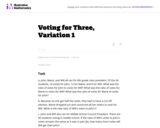
This problem is the fifth in a series of seven about ratios. In the first problem students define the simple ratios that exist among the three candidates. It opens an opportunity to introduce unit rates. The subsequent problems are more complex. In the second problem, students apply their understanding of ratios to combine two pools of voters to determine a new ratio. In the third problem, students apply a known ratio to a new, larger pool of voters to determine the number of votes that would be garnered.
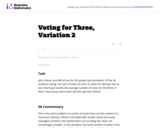
This is the sixth problem in a series of seven that use the context of a classroom election. While it still deals with simple ratios and easily managed numbers, the mathematics surrounding the ratios are increasingly complex.
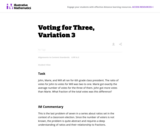
This is the last problem of seven in a series about ratios set in the context of a classroom election. Since the number of voters is not known, the problem is quite abstract and requires a deep understanding of ratios and their relationship to fractions.
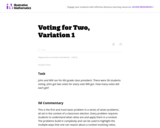
This is the first and most basic problem in a series of seven problems, all set in the context of a classroom election. Every problem requires students to understand what ratios are and apply them in a context. The problems build in complexity and can be used to highlight the multiple ways that one can reason about a context involving ratios.
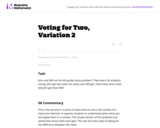
This is the second in a series of tasks that are set in the context of a classroom election. It requires students to understand what ratios are and apply them in a context. The simple version of this question just asked how many votes each gets. This has the extra step of asking for the difference between the votes.
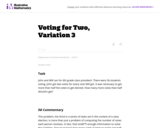
This problem, the third in a series of tasks set in the context of a class election, is more than just a problem of computing the number of votes each person receives. In fact, that isnŐt enough information to solve the problem. One must know how many votes it takes to make one half of the total number of votes. Although the numbers are easy to work with, there are enough steps and enough things to keep track of to lift the problem above routine.

This is the fourth in a series of tasks about ratios set in the context of a classroom election. What makes this problem interesting is that the number of voters is not given. This information isnŐt necessary, but at first glance some students may believe it is.

As the standards in statistics and probability unfold, students will not yet know the rules of probability for compound events. Thus, simulation is used to find an approximate answer to these questions. In fact, part b would be a challenge to students who do know the rules of probability, further illustrating the power of simulation to provide relatively easy approximate answers to wide-ranging problems.

This task is meant to be a straight-forward assessment task of graph reading and interpreting skills. This task helps reinforce the idea that when a variable represents time, t=0 is chosen as an arbitrary point in time and positive times are interpreted as times that happen after that.
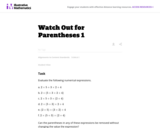
This problem asks the student to evaluate six numerical expressions that contain the same integers and operations yet have differing results due to placement of parentheses. It helps students see the purpose of using parentheses.

This problem asks the student to evaluate three numerical expressions that contain the same integers yet have differing results due to placement of parentheses.

The principal purpose of the task is to explore a real-world application problem with algebra, working with units and maintaining reasonable levels of accuracy throughout.
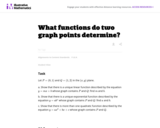
These problems give students the opportunity to construct and compare linear, quadratic, and exponential models.
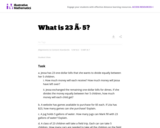
When a division problem involving whole numbers does not result in a whole number quotient, it is important for students to be able to decide whether the context requires the result to be reported as a whole number with remainder or a mixed number.

The words compose and decompose are used to describe actions that young students learn as they acquire knowledge of small numbers by putting them together and taking them apart. This understanding is a bridge between counting and knowing number combinations. It is how instant recognition of small numbers develops and leads naturally to later understanding of fact families. This task helps them develop an understanding of number combinations.

Students are asked to analyze the data in a graph and determine if there is an association between the two variables.

The triangle congruence criteria, SSS, SAS, ASA, all require three pieces of information. It is interesting, however, that not all three pieces of information about sides and angles are sufficient to determine a triangle up to congruence. In this problem, we considered SSA. Also insufficient is AAA, which determines a triangle up to similarity. Unlike SSA, AAS is sufficient because two pairs of congruent angles force the third pair of angles to also be congruent.
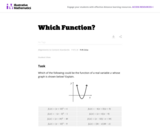
This task addresses knowledge related to interpreting forms of functions derived by factoring or completing the square. It requires students to pay special attention to the information provided by the way the equation is represented as well as the sign of the leading coefficient, which is not written out explicitly, and then to connect this information to the important features of the graph.